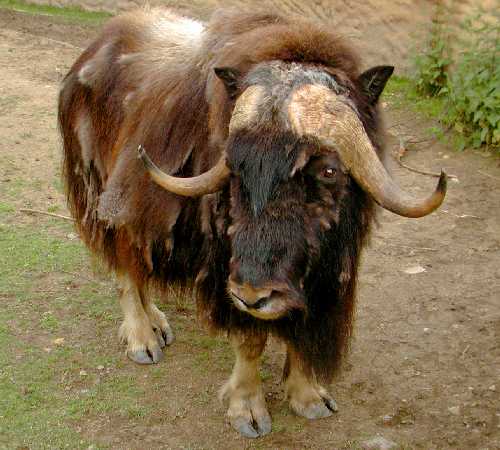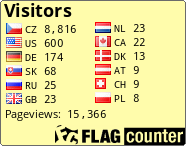CZ
Pizmon aljassky (Ovibos
moschatus)
Pižmon aljassky je velké, zavalité zvíre se zakulacenou
hlavou a celý je porostlý cernohnedou srstí sahající až na
zem. Pižmon aljašský je sice menší než
kráva, ale dosahuje výšky v kohoutku 90 až 150 cm, jeho
telo je dlouhé 200 - 250 cm a dosahuje hmotnosti 180 až 400
kg, proto pusobí mohutným dojmem. Na pižmoni upoutá masivní
celenka z dotýkajícími se základu rohu na hlave. Ty mužou být
až 70 cm dlouhé, ohýbají se smerem dolu a k ostré špici
se nebezpecne hákovite zahýbají.
Pižmoni pocházejí z chladných stepí s kontinentálním suchým
klimatem, proto jsou dost náchylní na dešte kombinované s
mrazem. Zmena klimatu byl nejpravdepodobnejší duvod vyhynutí
techto savcu v Evrope (cetné nálezy a fosílie dokládají, že
žili i u nás) a Asii v poledové dobe, kdy se výrazne
zvýšilo množství srážek. Do dnešních dnu se
podarilo pižmonum prežít jen v odlehlých a pustých
místech Aljašky, kanadské Arktidy a severovýchodního
Grónska. Ale i tady témer vyhynuli behem 19. století, kdy do techto
oblastí zacali pronikat obchodníci z kožešinami. Na
poslední chvíli byly naštestí vydány zákony na jejich
ochranu. V rámci nekolika ochranárských programu byla zvírata na
nejakých místech svého výskytu znovu vysazena, což zpusobilo
fakt, že dnes už znovu pižmon oživuje kamenitou
tundru i na Aljašce, na západe Grónska, na Tajmyrském
poloostrove v Rusku a v Evrope ve dvou horských oblastech strední
Skandinávie. Díky tvrdému režimu ochrany jejich pocet znovu
stoupá a dnes se pohybuje kolem 50 až 60 tisíc zvíraty.
Dokonce se v nekterých oblastech Kanady povoluje puvodním
obyvatelum - Eskymákum omezený lov nekolika desítek kusu rocne.
Zpusob zivota
Jedná se o zvíre žijící ve skupinách - v léte žije v
menších skupinách a v zime se houfuje do vetších
skupin, které mohou cítat až 100 kusu. V krutých mrazech
polární noci vyhledávají pižmoni vichricemi vyfoukané svahy
kopcu, kde je dostupná potrava v podobe vetví, pupenu nízkých vrb,
vresovcovitých rostlin a uschlých travin. Starí býci žijí
samotársky a jen v období rozmnožování se obklopují nekolika
kravami. Ríje zacíná v druhé polovine zárí a trvá asi mesíc. Samci
kolem sebe šírí pronikavý pach, podle kterého dostalo zvíre
ceské pojmenování. Jedná se o výmešek žláz umístených v
srsti nad ocima, který si vtírají do srsti na predních nohách. Býci
mezi sebou urputne bojují o prízen krav. V plném trysku se na sebe
rítí ze vzdálenosti nekolika desítek metru a zvuk narážejících
rohu do sebe jde slyšet na velkou vzdálenost. Boj pokracuje
tak dlouho, dokud jeden samec neustoupí. Brezost krav trvá 8 mesícu
a telata prichází na svet v kvetnu. Již od prvních dnu jsou
telata schopna následovat matku i stádo. Plne se osamostatnují
behem prosince, kdy prestávají definitivne sát mléko. Jalovice jsou
pohlavne dospelé v tretím roce života, býcci asi o dva roky
pozdeji. Pižmoni severní se mohou dožít až 35
let.
Obrana pred
neprateli
U pižmonu se vyvinul jeden z nejlepších zpusobu
obrany u býložravce proti predátorum. Pri objevení neprítele
se vylekaná zvírata rychle sbíhají do kompaktního kruhovitého
tvaru. Natisknou se k sobe tak, že zadek mají vevnitr a
hrozivou hradbou sklonených cel s nebezpecnými rohy vne kruhu.
Uvnitr kruhu se nacházejí telata a slabší zvírata.
Nejstarší a nejsilnejší clenové stáda provádejí proti
nepríteli tryskové útoky, které odradí i vyhladovelou smecku vlku.
Zatímco proti vlkum tato technika jednoznacne uspela, proti cloveku
nikoli a stala se jim osudnou. Statecnost a soudržnost
pižmonu je povestná už od pradávna. V novodobé historii
se nejednou stalo, že lovec, který chtel zabít jen nekolik
kusu pro potrebu, musel zabít celé stádo. Pižmoni totiž
hájí a neopustí ani mrtvá zvírata. Obranný pud se jim stává osudným
i v dnešní dobe, kdy na sever proniká množství turistu.
Pižmoni zaujímají kruhovou obranu i pri postrehnutí malého
letadla s turisty. Pri preletu je ale zachvátí panika a stádo se
dává na bezhlavý útek. Vystrašená zvírata také casto udupou
v panice svá telata.
Pižmone mužete spatrit krome ZOO Plzen také v ZOO
Liberec a ZOO Olomouc. ZOO Plzen zavedla chov pižmonu od roku
1998. Nyní chová samce Sida a Semmela a samici Piroschku.
Zdroj: www.wikipedia.org.

Neco o kesi
Kes je velikosti small, tvaru kvadru. Je tematicka, jsou v ni
ulozena zvirata, mente prosim co nejvice zviratek. Kes se nachazi
na velmi frekventovanem miste, obtiznost 3 ma tedy jedine diky
obtiznemu nenapadnemu odlovu, pokud je liduprazdra ZOO, klesa
obtiznost na 1,5+ proto doporucujeme odlov v rannich hodinach nebo
tesne pred zaviraci dobou ZOO. Kes prosim po vraceni dostatecne
zakryjte. Budeme radi, kdyz k logu prilozite zajimavou fotku
pizmone.
EN
Muskox
The muskox (Ovibos moschatus) is an Arctic mammal of the Bovidae
family, noted for its thick coat and for the strong odor emitted by
males, from which its name derives. This musky odor is used to
attract females during mating season.
Physical
characteristics
As members of the subfamily Caprinae of the family Bovidae,
muskoxen are more closely related to sheep and goats than to oxen,
but are in their own genus, Ovibos. Both genders have long curved
horns. Muskoxen stand 1.2 m (3 ft 11.2 in) high at the shoulder on
average, with females measuring 135 to 200 cm (53.1 to 78.7 in) in
length, and males 200 to 250 cm (78.7 to 98.4 in). Adults, on
average, weigh 285 kg (628 lb) and range from 180 to 400 kg (397 to
882 lb). The thick coat and large head often suggests a larger
animal than the muskox truly is, but overfed zoo specimens have
weighed up to 650 kg (1430 lbs). Their coat, a mix of black, gray,
and brown, includes long guard hairs that reach almost to the
ground. Rare "white muskox" have been spotted in the Queen Maud
Gulf Bird Sanctuary. Muskox wool, or qiviut (an Inuit word), is
highly prized for its softness, length, and insulative value.
Prices for yarn range between $40 and $80 per ounce (28 g).
Muskoxen are social and live in herds, usually of around
10–20 animals, but sometimes over 70. Winter herds consist of
adults of both sexes as well as young animals. During the mating
season, which peaks in mid-August, males compete for dominance, and
one dominant bull drives other adult males out of the group.
Non-breeding males will often form male only herds of 3-10 or
wander the tundra alone. During this period all males are extremely
aggressive. Bulls will even charge birds if they are close by.
Females are sexually mature at two years of age, and males reach
sexual maturity after five years. The gestation period is eight or
nine months. Almost all pregnancies yield single calves. The young
nurse for a year, but may start to eat grasses as soon as a week
after birth. Muskoxen have a distinctive defensive behavior: when
the herd is threatened, the bulls and cows will face outward to
form a stationary ring around the calves. This is an effective
defense against predators such as wolves, but makes them an easy
target for human hunters. Besides wolves, the only natural
predators of muskoxen are the grizzly (brown) bear and polar bear.
The muskox, or its ancestor, is believed to have migrated to North
America between 200,000 and 90,000 years ago. It is agreed however
that the muskox was alive in the Pleistocene period making it a
contemporary of the mammoth. It is thought that the muskox was able
to survive the last ice age (Wisconsin glaciation) by finding ice
free areas away from prehistoric peoples. The muskox gradually
moved across North America and arrived in Greenland during the late
Holocene.
Habitat and range
Muskoxen are native to the Arctic areas of Canada, Greenland,
and Alaska. The Alaska population was wiped out in the late 19th or
early 20th century, but muskoxen have since been reintroduced to
Alaska. The United States Fish and Wildlife Service introduced
muskox onto the Nunivak Island in 1935 as a means for sustenance
living. The species has also been reintroduced from Banks Island to
northern Europe, including Sweden, Estonia, the Dovre mountain
range of Norway, and Russia and from Ellesmere Island to Eastern
Canada. In the province of Quebec, muskoxen were close to
extinction at one point, but have recovered after being protected
from hunting. The world population is estimated at between 80,000
and 125,000, with an estimated 68,788 living on Banks Island.
During the summer, muskoxen live in wet areas, such as river
valleys, moving to higher elevations in the winter to avoid deep
snow. They graze on grasses, reeds, sedges, and other ground
plants, digging through snow in the winter to reach their food. The
last known muskox population outside North America lived on the
Taymyr Peninsula of Siberia, and died out about 2,000 years ago.
The muskox was successfully reintroduced on the Taymyr Peninsula in
1975.
In Czech Republic you can see Moskox except ZOO Plzen also in
ZOO Liberec and ZOO Olomouc. ZOO Plzen began to beed moskox in
1998. Now they have males Sid and Semmel and female Piroschka.
Source: www.wikipedia.org.
About the cache
It is a small type of cache. The cache is thematic with deposit
of animals, please trade many animals. It is on the frequent spot
with plenty of muggles, that's the reason of difficulty 3, if there
are no people around, difficulty is about 1,5, so we recommend to
hunt it in the morning or around closing time of the ZOO. Please
cover the cache after your log carefully. We appreciate some
interesting pictures of moskox in the logs.
